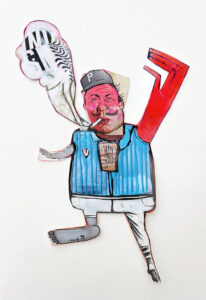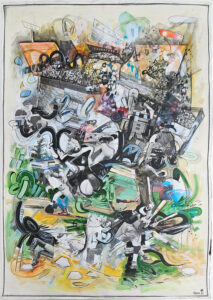Riffing on the 1980s
4/3/2024
“Little League in the 80s”
by Chris Vance
Chris Vance’s annual show at Moberg Gallery cements his stature as Des Moines’ most popular painter. Some 32 of the paintings were sold before the exhibition even began. Vance consciously comments each year on what he finds most interesting about the contemporary world outside his studio. This year it’s AI and how it can regenerate old ideas and attitudes while synthesizing something new and original.
A visual voice for Gen Xers, Vance comments this year, among other things, on baseball and smoking in the 1980s. “Little League Dream” is nostalgia in cut paper. Gallery archivist Michaela Mullin calls it “dark and dusty as a softball field of activity, kicking up dirt. The black and white collaged pieces show up in a blur, figurative subjects in parts — legs and feet here, upper body there, a ball in midair somewhere between, etc. Subjects seem to be running bases, and the green swirls make grass at the forefront of the paper, while at the top, the stadium panels in perspective hold lights to shine on everything below.”
In keeping with his “looking back is looking forward” approach, Vance creates room for a relatively new social-taboo by offering viewers a smoking section. In “Little League in the 80s,” Vance shows a coach smoking a cigarette between red lips. Mullin notes “a mustache and neon pink blush accessorize this otherwise masculine-leaning character in mid-air.”
The smoke he emits appears as comic book speech balloons, but without words. Mullin calls that a commentary on how adults in the 1980s did or did not communicate with kids.
Most of Vance’s whimsical characters are back, as are skate boards and musical riffs. The show’s title, “Sampled,” refers to AI in 1980s music, when old tracks were recreated in new music, like leitmotifs. The show plays through April 6.

“Little League Dreams” by Chris Vance
Big picture
Global sales of art and antiques slipped 4% to an estimated $65 billion, according to the annual art market report from Art Basel. Though the market slumped, the total — which includes sales at auction houses, galleries, and art fairs — remained slightly higher than a pre-pandemic level of $64.4 billion in 2019.
Ode to joy at 200
Des Moines Symphony’s 86th season culminates in the rapture of “the B9.” Beethoven’s Symphony 9 in D minor was his final completed symphony, composed when the maestro was totally deaf. It’s the most ambitious work any symphony can take on with a 150-voice choral accompaniment. For divine coincidence, it will be performed May 11 and 12, two and three days after its 200th anniversary. Franz von Suppé’s “Queen of Spades” and Valerie Coleman’s “UMOJA” (Swahili for unity) precede the rapture.
Return of the Okoboji kid
Leads are cast for Des Moines Metro Opera’s (DMMO) “Pelléas et Mélisande,” Claude DeBussy’s only finished opera from the composer’s Wagnerian middle period. This new production features the return of Okoboji baritone John Moore in a role debut as the ill-fated Pelléas and soprano Sydney Mancasola as the tragic Mélisande.
Moore sang the role of Jess in the world premiere of Kristin Kuster and Mark Campbell’s “A Thousand Acres” in DMMO’s 50th anniversary season. He sang the titular role in “The [R]Evolution of Steve Jobs” for operas of Austin, Atlanta, San Francisco, Utah and Kansas City.
Mancasola, a regular for the world’s most popular opera in Berlin and also in Frankfurt, returns after singing the role of Tatania last year in “Midsummer’s Night Dream.” She also sang the role of Pamina in the Metropolitan Opera’s “The Magic Flute” last year as well as playing Laura Brown there in “The Hours.” She made her Los Angeles Opera debut last year singing Mélisande. n





















